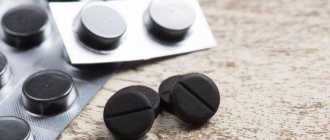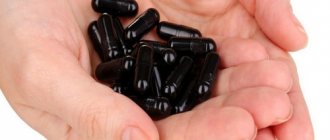Composition and properties of activated carbon
The main elements in the composition of this drug are several types of organic coal: charcoal, coconut, petroleum coal shavings and coal coke. The production of activated carbon is achieved by thermal treatment of the material using high temperatures up to 1000ºC without access to oxygen and subsequent chemical treatment.
The product has a finely porous structure, which contributes to its adsorption and catalytic ability, which allows it to absorb harmful substances and remove them from the body, cleansing it. The drug is capable of reducing the effect of toxic substances by more than half. Coal is chemically passive, does not react with body fluids, does not dissolve, and leaves the body with the natural excrement of feces. In this case, the stool may turn black, which in this case is normal and should not cause concern.
The benefits and harms of activated carbon for pancreatitis
Activated carbon absorbs any substances - harmful (gases, toxins, waste and other harmful metabolic products) and valuable (vitamins, minerals and nutrients obtained from food). But you shouldn’t get carried away with this drug.
It is recommended to maintain a time interval of at least 3 hours between taking charcoal and other medications for pancreatitis in order to prevent the products of other medications from being removed from the body and weakening their effectiveness. For the same reason, it should not be consumed less than a few hours before or after a meal.
Activated carbon for pancreatitis: beneficial properties and contraindications
There are clear contraindications to the use of activated carbon for pancreatitis; first of all, the tablets are undesirable during pregnancy. It is harmful to drink coal and do not follow the drinking regime; the likelihood of dehydration increases.
Another prohibition is the use of the drug for constipation against the background of chronic pancreatitis; the tablets absorb moisture and will further worsen the patient’s well-being. The same rule is relevant in the presence of bleeding of the lower intestines.
The drug is usually easily tolerated by the body, and an overdose does not occur. But it is still not advisable to self-medicate; pills should be taken after consultation with the doctor. This helps eliminate the risk of adverse reactions, select an adequate dosage, and eliminate significant contraindications, dehydration, and severe nutritional deficiencies.
As reviews show, there is a possibility of intolerance to the components of the product. Doctors also prohibit activated charcoal for severe diseases and damage to the digestive system, these include:
- ulcerative colitis;
- stomach ulcer, duodenal ulcer;
- injuries to the mucous membrane of the digestive tract;
- excessive sensitivity of the intestines and stomach;
- bleeding of the gastrointestinal tract.
It is better not to take risks and give up coal if diseases of the gastrointestinal tract have become acute or chronic; the drug can cause serious harm to health.
Activated carbon tablets should be stored away from substances that can release vapors or gases. When stored in air, especially humid air, the effectiveness of the drug decreases and sorption capacity deteriorates.
Information about activated carbon is provided in the video in this article.
Indications and contraindications for use
Purpose principles
The drug can be taken in the following cases:
- poisoning and intoxication;
- inflammatory and infectious processes;
- increased gas formation and flatulence;
- fermentation and sepsis in the intestines;
- hypersecretion of gastric juice;
- dysfunction of the liver and kidneys due to their diseases;
- metabolic disorders;
- pancreatitis.
The use of this remedy for pancreatitis results in improved intestinal function and relieves pain.
In acute pancreatitis, it helps to reduce dyspepsia and relieve pain. In the case of a protracted chronic form of the disease, it is used to cleanse the blood of decay products and remove residual masses of food that have not been absorbed due to the poor condition of the pancreas. Indicated to improve intestinal function.
In general, regular use of this remedy for pancreatitis helps achieve the following results:
- elimination of intoxication;
- decrease in acidity;
- normalization of blood clotting parameters;
- reduction of dyspeptic symptoms;
- improvement of gastrointestinal motility;
- general correction of the condition of the mucous membrane of the stomach and intestines.
Cautions
Contraindications for the use of activated carbon are internal bleeding in the gastrointestinal tract, the presence of which may be indicated by the presence of blood in the vomit. Peptic ulcers and individual intolerance to the drug cannot be treated with charcoal. It is not recommended to take it during pregnancy, as this can lead to disruption of the body's water balance, and for the same reason, those suffering from constipation should be wary.
Treatment of pancreatitis with activated carbon
Pancreatitis is an unpleasant and dangerous disease.
Among the variety of drugs for its treatment, activated carbon has a special place, especially when it comes to exacerbation or transition of the disease to the chronic phase. It is this composition that makes it a magical remedy that draws out all toxins and breakdown products from gastrointestinal poisoning. Doctors recommend taking it if necessary:
- remove salts and heavy metals from the body;
- stabilize the absorption of nutrients in the intestines;
- remove glycosides and alkaloids from the body as quickly as possible;
- help the body remove drug residues.
Important! Before taking activated carbon, you need to understand that the “hot hand” of drugs includes not only substances harmful to the body, but also useful ones, so independent and long-term use can be dangerous for your health.
Doctors most often prescribe activated charcoal for pancreatitis so that it helps remove food particles that have not been digested or have been partially digested, because the patient has impaired functioning of the pancreas.
Basically, it is prescribed at the very beginning of the disease, and to reduce pain, dyspepsia and extensive spasms, it is prescribed both during exacerbation and chronic forms of the disease. Although it is the chronic form of the disease and its use that still causes fierce debate among doctors, because there is an opinion that it is ineffective for it.
Taking activated carbon for pancreatitis affects the gastrointestinal tract as follows:
- The acidity of the pancreatic fluid decreases.
- The symptoms of dyspepsia are eliminated.
- The level of intoxication in the body decreases.
- The mucous membrane is restored and returns to normal.
- It prevents ulcerative formations.
- Peristalsis improves, which contributes to the timely cleansing of feces from the body.
- Reducing body weight.
Important! When taking activated carbon and other medications, a strict time interval must be observed, which cannot be less than 3 hours, since the effectiveness of the medications will be significantly reduced.
How to use
To avoid harm to yourself when activated charcoal is prescribed to you, ask your doctor how to take this medicine. In case of pancreatitis, its intake should be accompanied by plenty of drinking, because this is the only way to obtain the desired therapeutic effect and avoid dehydration.
Usually the medicine is available in tablet and powder forms. It can be accepted:
- With a glass of water to wash down the required amount of product.
- With a tablespoon of water, in which the powdered product is mixed until it becomes a porridge, and then washed down with plenty of water.
Interesting! It has been proven that when taking the drug in the second way, its effectiveness and speed of action are much higher than with the first option.
Despite the fact that activated carbon is found in almost every pharmacy in our country and is used frequently, the dosage of the drug must be selected very carefully. Especially when it comes to pancreatitis.
Important! The permissible maximum of the drug is calculated as 1 tablet per 10 kg of person’s weight. For patients with non-critical medical conditions, the full dose may be divided into two doses. The duration of treatment for pancreatitis is 2 weeks.
Contraindications
Like any other medicine, activated carbon has contraindications. The following are a number of precautions that must be followed in order not to harm your health:
- Due to the strong adsorbing properties of the drug, it is strictly forbidden for pregnant and lactating women, since there is a clear threat of dehydration, which can harm both mother and child.
- If you are prone to constipation, activated carbon is also contraindicated, as it will only complicate the existing situation.
- Individual intolerance.
- A person is sick with pancreatitis, but he has other problems with the gastrointestinal tract, which include:
- ulcers and ulcerative colitis;
- any injury to the gastrointestinal mucosa;
- bleeding in the stomach and related organs;
- extreme sensitivity of the gastrointestinal tract.
It is also important that activated carbon is not completely eliminated from the body. Its excess leads to disruptions in the gastrointestinal tract and deterioration in the absorption of nutrients. For patients with extreme stomach sensitivity, taking activated charcoal is very dangerous, because it can cause erosion in the gastrointestinal tract.
For the treatment of pregnant and lactating women suffering from pancreatitis, the drug will be selected taking into account the risk assessment for the health of the mother and her baby. Usually gentle drugs are used. They have a higher cost, but they are harmless, which means they will have the desired effect, but will not harm anyone.
All of the above proves the high effectiveness of the drug in the treatment of pancreatitis, but you should not treat it negligently, because failure to comply with the dosage or use when contraindicated can cause deterioration in health. Therefore, you should not self-medicate; this is the responsibility of your attending physician.
Activated carbon is the most famous and effective adsorbent today. It is popular not only due to its effective effect on the body and fairly low price, but also because of its composition and easy-to-take structure.
One tablet of activated carbon contains the following components:
- charcoal;
- coconut charcoal;
- petroleum coal shavings;
- coal coke.
Due to such components and porous texture, the drug acts as a kind of vacuum cleaner, sucking out harmful toxic substances from the digestive system.
Activated carbon affects the following processes:
- Slowing down the absorption of beneficial components in the gastrointestinal tract;
- Removal of salt and heavy metals;
- Removal of alkaloids and glycosides from the body;
- Cleansing the body of drug residues.
However, in no case should we forget that along with toxins, the medicine also adsorbs beneficial enzymes. Because of this, you should not take the medication on your own without following the daily dose in order to prevent its negative effect on the body.
Activated carbon for pancreatitis is prescribed to cleanse the body of food particles accumulated in the gastrointestinal tract that have not been completely digested due to impaired activity of the pancreas. Most often, doctors prescribe the drug in the initial stages of the disease.
You can take activated charcoal for acute pancreatitis to relieve cramping pain and dyspepsia. But if we talk about treatment with a drug for exacerbation of chronic pancreatitis, then in this case, according to doctors, it is ineffective.
With pancreatitis, charcoal has the following effects on the gastrointestinal tract:
- reduces the acidity of pancreatic fluid;
- relieves symptoms of dyspepsia;
- normalizes the general condition of the blood;
- saves the body from intoxication;
- helps restore and improve the gastric mucosa;
- prevents the appearance of ulcers in the stomach;
- improves peristalsis of the gastrointestinal tract.
But it should be remembered that before taking activated charcoal for pancreatitis, you need to note the time between the use of other medications. The time gap must be at least 3 hours.
The properties of the drug to adsorb useful substances should be taken into account. If activated carbon is taken together with any other medications, their properties will decrease significantly, or the effect will not be visible at all.
We suggest you read: Prevention of treatment of the liver and pancreas
With the correct dosage of the drug, you can achieve a positive therapeutic effect in treatment and even get rid of a few extra pounds.
- 1 Description
- 2 Application 2.1 Activated carbon for acute gastritis
- 2.2 For chronic gastritis
How to take activated carbon?
Most people consider activated charcoal to be harmless, but it is still a medicine, so not everyone can take it.
The medicine for pancreatitis should be taken with plenty of liquid to avoid dehydration of the body, and an accelerated effect can be achieved by taking the drug crushed, that is, in powder form. From the powder and a small amount of water you can get a suspension - a thick gray liquid that you should drink. In this form, the product acts faster. The maximum permissible dose for a single dose is calculated based on the patient’s body weight and should not exceed one tablet (0.25 g) per 10 kg of weight. If the condition is not critical, it is better to divide the required amount of the drug into several parts and take it several times during the day, for example, 3-4 tablets at a time. The duration of treatment for pancreatitis should not exceed 10-14 days.
Dosage regimen for pancreatitis
It is necessary to treat pancreatitis with activated carbon strictly following the recommendations of the attending physician. Incorrect use of the medication can result in dehydration due to the high adsorbing properties of the substance.
The summary for the drug does not contain information about the use of the drug for pancreatitis . In this condition, you can take Activated Charcoal in tablets (capsules) or crush the medicine and prepare a suspension from it. Children are recommended to drink activated carbon in capsules. This form of medication is easier to swallow. Drink with 1-2 glasses of water.
For acute attacks, it is permissible to crush the required dose of the medicine to a powdery state, add water to the resulting mass and mix. The finished product should have the consistency of low-fat sour cream. It is recommended to drink the solution in small sips. Taking the mixture in one gulp may cause vomiting. After swallowing the suspension, you should drink at least 1 glass of liquid.
Consuming the powder helps quickly eliminate the unpleasant symptoms of pancreatitis. The effect is observed 15-30 minutes after administration.
To prevent undesirable consequences, do not exceed the recommended amount of the drug. The dose of Activated Carbon is calculated taking into account the patient’s body weight. The recommended amount of the drug is no more than 250 mg (1 tablet) per 10 kg of weight . In case of chronic or sluggish pancreatitis, tablets can be taken in fractions. To do this, the daily dose must be divided into several doses. The duration of therapy for pancreatitis with charcoal is 10-14 days.
The dosage regimen is changed by the attending physician when the disease goes into remission. Often, 1 tablet of Activated Carbon per day is prescribed as maintenance therapy.
Brief conclusion
Taking into account the peculiarities of the drug’s action, we can conclude that in acute and critical conditions with pancreatitis, it is possible to use it urgently without consulting a doctor - short-term use is much more likely to bring benefit than harm. In the case of chronic conditions and the need for long-term and regular use, the dosage and duration of use of activated carbon is prescribed by the attending physician. After completing the course of treatment for pancreatitis, it will be appropriate to take vitamin-mineral complexes and probiotics that normalize the intestinal microflora.
Properties of the drug and interactions with other drugs
Activated carbon for pancreatitis is prescribed to cleanse the body of food particles accumulated in the gastrointestinal tract that have not been completely digested due to impaired activity of the pancreas. Most often, doctors prescribe the drug in the initial stages of the disease.
You can take activated charcoal for acute pancreatitis to relieve cramping pain and dyspepsia. But if we talk about treatment with a drug for exacerbation of chronic pancreatitis, then in this case, according to doctors, it is ineffective.
With pancreatitis, charcoal has the following effects on the gastrointestinal tract:
- reduces the acidity of pancreatic fluid;
- relieves symptoms of dyspepsia;
- normalizes the general condition of the blood;
- saves the body from intoxication;
- helps restore and improve the gastric mucosa;
- prevents the appearance of ulcers in the stomach;
- improves peristalsis of the gastrointestinal tract.
But it should be remembered that before taking activated charcoal for pancreatitis, you need to note the time between the use of other medications. The time gap must be at least 3 hours.
The properties of the drug to adsorb useful substances should be taken into account. If activated carbon is taken together with any other medications, their properties will decrease significantly, or the effect will not be visible at all.
With the correct dosage of the drug, you can achieve a positive therapeutic effect in treatment and even get rid of a few extra pounds.
Reception and dosage for pancreatitis
After the doctor prescribes treatment with activated carbon, it is necessary to clarify how it should be used correctly. It should be taken with plenty of fluid to prevent the medication from working incorrectly and to avoid dehydration.
You can drink activated carbon in two ways - as tablets and as a mixture of powder and liquid.
- With the first method, you just need to take the required number of tablets or capsules and drink 1-2 glasses of water.
- As for the second option, you should crush the tablets to a fine powder, add a small amount of water and stir. The mixture should be medium thick, dark gray in color, which should be taken orally and washed down with another glass of liquid.
If you take the drug in the second way, it will act much faster and more effectively.
Activated carbon, although it is a common remedy that is in every home medicine cabinet and has been tested for years, is still a medicinal drug. Therefore, the correct dosage must be carefully observed.
The maximum dose of the substance per dose should not exceed one tablet per 10 kilograms of the patient’s weight. If the patient’s condition cannot be called critical, then the dose is divided into several parts. Reception can be carried out 3-4 times throughout the day. The course of treatment with charcoal for pancreatitis lasts from 10 to 14 days.











